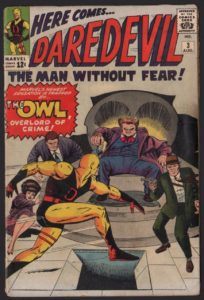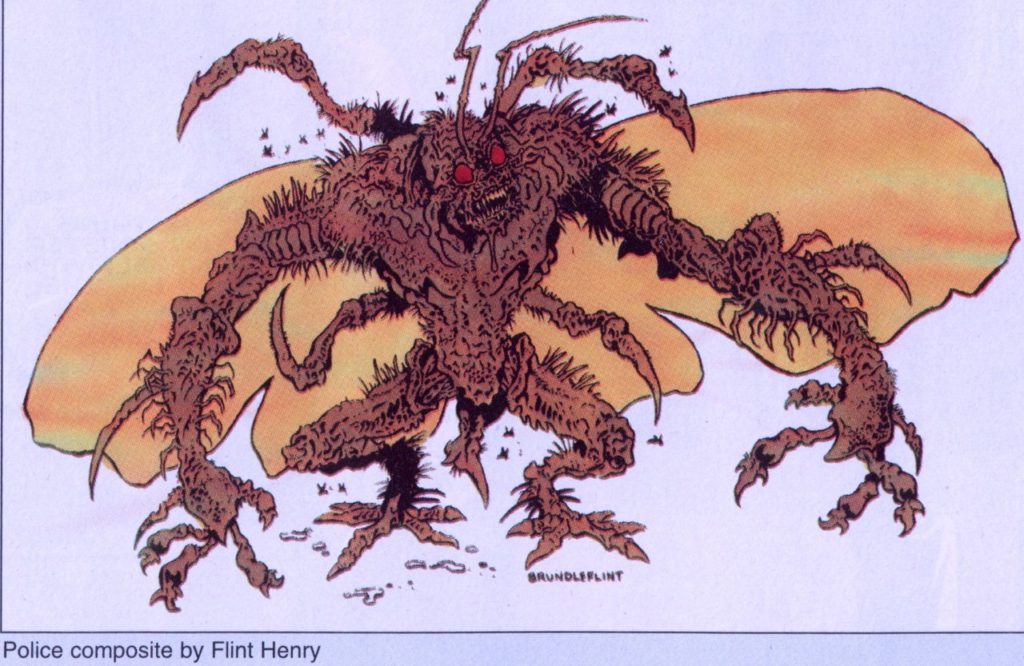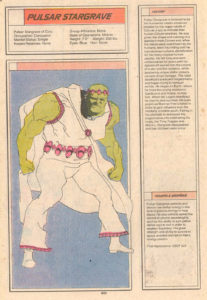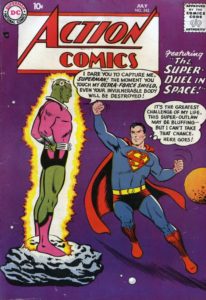
Comic book characters enjoy many lives. As long-running heroes and villains enter new decades and entertain new generations, they very often experience significant changes – “revamps” – to update their occasionally archaic (and corny) motifs. Hundreds of characters have experienced dozens of revamps apiece, but here’s a trio where the road to change was a rocky one indeed…
The Owl
 Fans of Netflix’s Daredevil series will be familiar with Leland Owlsley – better known as “The Owl” in the source material – as a wry, disdainful factotum of Vincent D’Onofrio’s portrayal of Wilson Fisk, a.k.a. The Kingpin. But the character’s origins date back almost to the very first appearance of Daredevil in the comics, and might surprise newly-arrived fans.
Fans of Netflix’s Daredevil series will be familiar with Leland Owlsley – better known as “The Owl” in the source material – as a wry, disdainful factotum of Vincent D’Onofrio’s portrayal of Wilson Fisk, a.k.a. The Kingpin. But the character’s origins date back almost to the very first appearance of Daredevil in the comics, and might surprise newly-arrived fans.
Debuting in the third issue of Daredevil, released in 1964, Leland Owlsley was originally a corrupt financier who escaped incarceration at the hands of the IRS in the most reasonable way possible: By moving into an owl-shaped ship on the opposite side of the Hudson River and establishing himself as a crime lord. A heavyset man decked out in a Victorian cape and Little Lord Fauntleroy necktie, The Owl had a couple of tricks hidden up his forest green sleeves. For one thing, he could glide on air currents, owing to a combination of scientific tomfoolery and natural mutation. For another, he wore a pair of razor-sharp metal talons under his sleeves, ready to cut and slash at a moment’s notice.
The Owl remained a relatively unremarkable villain for most of his career, eventually dropping out of regular rotation among Daredevil’s foes. When he returned, he’d undergone a gruesome alteration. Outfitting himself with cybernetic enhancements, Owlsley adopted more characteristics of his namesake including the ability to twist his head a full 360 degrees and glowing eyes which could see clearly in pitch blackness.
The cybernetics ended up harming Owlsley more than helping him, possibly explaining how he returned eventually as a non-mechanically-enhanced, small-time drug lord shouldering his way into Kingpin’s territory. Brutal, tough and unflinching, it was a new and different Owl than we’d seen before, but even this change has run its course. Capitalizing on the common owl’s reputation for excellent eyesight, The Owl was last seen on the printed page as a human panopticon, attached to hundreds of television cameras and observing the secrets of the world around him…
Killer Moth
 One of the more memorably unusual foes of Batman’s famous rogues gallery, Killer Moth is the possessor of an almost incomprehensible backstory, complicated by conflicting modus operandi and identities. Still, his distinctive moth-helmeted, winged, striped costume and its baffling color palette of violet, green, yellow and orange makes this “anti-Batman” – he billed himself as the natural opposite of Batman – a striking figure, at the very least. And his accoutrement of a secret Mothcave, a Moth-Signal, a Moth-mobile and so much more gave him a familiar appeal to longtime fans of the Caped Crusader.
One of the more memorably unusual foes of Batman’s famous rogues gallery, Killer Moth is the possessor of an almost incomprehensible backstory, complicated by conflicting modus operandi and identities. Still, his distinctive moth-helmeted, winged, striped costume and its baffling color palette of violet, green, yellow and orange makes this “anti-Batman” – he billed himself as the natural opposite of Batman – a striking figure, at the very least. And his accoutrement of a secret Mothcave, a Moth-Signal, a Moth-mobile and so much more gave him a familiar appeal to longtime fans of the Caped Crusader.
As comics entered the grim-and-gritty 90s, however, the garishly colored Killer Moth was a non-starter. Making a deal with a literal demon from Hell, Killer Moth is upgraded to a grotesque moth creature
which calls itself Charaxes. A slavering beast of unfathomable power, his lost humanity is Killer Moth’s least concern. Now capable of feats of tremendous strength, the actual ability to fly, and projecting sticky acid which is capable of dissolving men into goo, the former Killer Moth seemed to have comfortably fit into his new role.

For a while, anyway. Leaving the Nineties behind, the 21st Century Killer Moth shed his monstrous form and re-adopted the mask-and-gun route. As DC Comics chose to reset their universe (again), Killer Moth was now an unknown figure in a mothwing-pattern painted jacket and carrying a compressed air gun of considerable power. His threat level seemed to rise dramatically.
But what’s happened after that? Well, owing to renewed interest in the villain after appearances – in his original costume – in shows like Batman:Brave and the Bold and his representation in assorted Lego-inspired media, it appears that the original Killer Moth is effectively back, in living color. That’s a long and winding road just to end up right where you started.
Brainiac
 Speaking of ending up where you started, Superman’s implacable intergalactic foe with the twelfth-level computer mind has had a curious journey since his initial debut at the start of the Silver Age. In his first appearance, Brainiac is less a supervillain and more a vehicle by which Superman was reunited with the miniaturized survivors of his homeworld, Krypton, inside the Bottle City of Kandor. A random alien menace and thief of living cities, Brainiac also pucks Metropolis from Earth before making the fatal mistake of returning to suspended animation – the upcoming journey through space would be too much for his mortal frame – and giving Superman a chance to restore most of Brainiac’s victims to full-size.
Speaking of ending up where you started, Superman’s implacable intergalactic foe with the twelfth-level computer mind has had a curious journey since his initial debut at the start of the Silver Age. In his first appearance, Brainiac is less a supervillain and more a vehicle by which Superman was reunited with the miniaturized survivors of his homeworld, Krypton, inside the Bottle City of Kandor. A random alien menace and thief of living cities, Brainiac also pucks Metropolis from Earth before making the fatal mistake of returning to suspended animation – the upcoming journey through space would be too much for his mortal frame – and giving Superman a chance to restore most of Brainiac’s victims to full-size.
In fact, it wasn’t until 1964 that Brainiac was officially declared to be a sophisticated android with a computer mind. In either an effort to placate the manufacturer of a child’s science playset – also named Brainiac – or an attempt to jump on the apparent bandwagon, DC wove an origin tale of Brainiac which affirmed the villain’s mechanical makeup.
Robotics remained at the core of Brainiac’s character, even through the scintillating Seventies and a trip to the far-flung 30th Century. Lightly disguising himself in a white pantsuit and cape, masquerading as a character named Pulsar Stargrave. That somewhat risible incarnation wrapped up unceremoniously, paving the way for an even more mechanical Brainiac to take the stage. Converted to a being of pure energy by a backfiring deathtrap, Brainiac reassembles himself following a disembodied tour of the history of the universe.
 He emerges from this experience in a new, intimidating and incontrovertibly mechanical body, resembling an alien skeleton made of glittering silver. Interpreting his non-corporeal journey as a religious experience, he brands Superman the avenging “angel of death” of a nearly omnipotent “Master Programmer” who seeks Brainiac’s dissolution.
He emerges from this experience in a new, intimidating and incontrovertibly mechanical body, resembling an alien skeleton made of glittering silver. Interpreting his non-corporeal journey as a religious experience, he brands Superman the avenging “angel of death” of a nearly omnipotent “Master Programmer” who seeks Brainiac’s dissolution.
After the Crisis on Infinite Earths, Brainiac was once again human – too human, in fact. A circus mentalist named Milton Fine became the recipient of an alien scientist’s tremendous and disembodied mind, and launches a plan of conquest under his sideshow handle “Brainiac.”
The proper Brainiac eventually regains his own human form, which is subsequently taken away and revamped repeatedly every few years. As Brainiac, Brainiac-13, Brainiac-6, Superman’s recurring computerized for has taken on just about every conceivable look and gimmick, with dozens more inevitably still in the queue.



